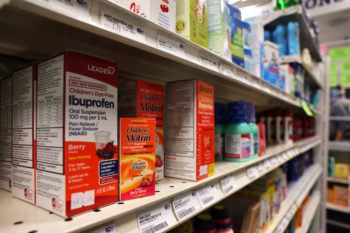What’s Behind The Amoxicillin Shortage, Explained By A Texas A&M Pharmacist

While a “tripledemic” of RSV, flu and COVID-19 continue to strain health care systems across Texas and the U.S., drug shortages are also complicating patient care during this year’s severe respiratory virus season.
Among the challenges is a scarcity in amoxicillin, which the Centers of Disease Control and Prevention considers a “first-line therapy” for bacterial ear infections and other common illnesses in children. The U.S. Food and Drug Administration added amoxicillin oral powder for suspension to its list of drug shortages in late October, stoking concerns among parents, pharmacists and physicians.
Texas A&M Today spoke with George Udeani, clinical professor and Department of Pharmacy Practice head at the Irma Lerma Rangel School of Pharmacy, about what’s behind the shortages and the potential consequences for health care providers and patients.
What kind of medication shortages are being reported during the current surge in respiratory infections?
Drug shortages during the current surge in respiratory infections have included liquid Tylenol (acetaminophen), Advil, Motrin (ibuprofen) and amoxicillin.
In the case of amoxicillin, what illnesses is it usually prescribed to treat?
Amoxicillin is used to treat Infections of the ear (inner ear infections in children), nose and throat. Additionally, it can be used to treat lower respiratory and urinary tract infections, as well as skin and skin structure infections.
How are these drug shortages affecting doctors and pharmacists?
Overall, these shortages are causing delay in care. Pharmacists do not have the ability to automatically substitute for other antibiotics when specific agents are prescribed by physicians. Thus, pharmacists must reach out to physicians for alternatives or send patients to other pharmacies, resulting in delay in care. Regarding liquid Tylenol (acetaminophen), Advil and Motrin (ibuprofen) shortages, pharmacists are under pressure to recommend the use of tablets, which concerns them, given that most of the formulations are predominantly available in adult dosages. Acetaminophen and ibuprofen have been associated with liver and kidney failure, respectively, in high doses.
What could be the consequences for patients?
Delay in care, prolonged ailments, increased emergency room visits, hospitalization and death in some instances have occurred.
What’s causing these shortages? How common is a lack of availability of this level in the U.S.?
These shortages have been associated with the uptick in influenza and respiratory syncytial virus (RSV) infections, as well as COVID-19 infections. This has resulted in the hoarding of liquid acetaminophen and ibuprofen, used to treat fever and pain, from several pharmacies, by consumers. The shortage of these products is common in the U.S. Antibiotic usage has increased 46% around the world since 2000, and amoxicillin is a medication that is in high demand globally. Only a few countries produce the active pharmaceutical ingredient for amoxicillin, and some of these manufacturers have also suffered regulatory sanctions, and are unable to continue to manufacture and supply these products.
What else do people need to know about the shortage, particularly parents with young children?
They have to communicate well with their physicians and pharmacists. They have to ask their physicians to prescribe alternatives to amoxicillin and consult with their pharmacists in advance to ensure availability of these medications. They also need to consult with their pharmacists on how best to use smaller individualized (tablet) doses of acetaminophen and ibuprofen in children to ensure that children do not receive toxic doses that could result in liver and/or kidney damage.
Media contact: Shelby Purdy, Irma Lerma Rangel School of Pharmacy Communications, shelbypurdy@tamu.edu





